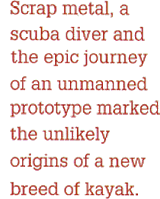 Profile: Roy Grabenauer Profile: Roy Grabenauer
Inventor of Sit-On-Top Kayaks
by Jeff Lancaster
Seven hundred and forty-two. The number of days that Roy Grabenauer's unmanned prototype kayak bobbed about in the Pacific Ocean before it was discovered by a somewhat bewildered Mexican albacore fisherman.
"It was the perfect test of a product's endurance," says Grabenauer. "When it was recovered, it still had the diving equipment and even a can of soda in its open storage compartment."
 |
| Above left: A photo taken by Roy of the 1945 prototype. Right, Roy with the 1967 boat. |
More than two years earlier, with a group of diving buddies watching from the safety of shore, Roy Grabenauer tested his aluminum prototype kayak in the rough waters of Salt Point, north of San Francisco. While Roy was diving with a friend, the anchor line to the kayak broke, and the tiny vessel was sucked out to sea.
"I thought that was the last I'd ever see of it," he said. "I couldn't believe it when it reappeared years later."
These days, the errant prototype has a place of honor on a wall at Royak Marine, the Sacramento, California-based, company Roy started in the early 1970's that still manufactures sit-on-top kayaks based on that original design.
 Today's Royak sprang from an improbable beginning. According to Roy's son Steve, who now owns and operates Royak Marine, the design for the original sit-on-top kayak had its origins back in 1945 toward the end of World War II, , when Roy was still stationed at Burma with the U.S. Army Maintenance Division. Today's Royak sprang from an improbable beginning. According to Roy's son Steve, who now owns and operates Royak Marine, the design for the original sit-on-top kayak had its origins back in 1945 toward the end of World War II, , when Roy was still stationed at Burma with the U.S. Army Maintenance Division.
"Dad and a buddy coupled together the wing tanks of a fighter plane," says Steve, recalling his dad's often-repeated legend. "They tied the two wing tanks together and placed an outboard motor between them."
A decade later, Roy was living in Northern California and had taken up diving for recreation.
"We'd use inner-tubes for diving," says Roy, recalling his earlier days diving and exploring the waters of Northern California. "We'd paddle out from shore with them and place our gear in a gunnysack in the center."
While the inner tubes made diving a little easier, they still weren't as effective as Roy had hoped. They were awkward to maneuver and didn't allow for great range, restricting divers to close-to-shore locations.
In the late 1950s, a friend of Roy's purchased a half-dozen aircraft wing tanks from a military store for a private venture. The wing tanks sparked Roy's memories of his earlier World War II design, and he set about creating a vessel that would make it easier to get to remote diving spots.
 |
| Roy with his namesake boat in 2004 |
 |
Using two of the wing tanks obtained from his friend, Grabenauer cut each wing tank in half horizontally and constructed a surfboard-type arrangement with a flat deck and a box-like section in the front for storage. The initial design was about eight or nine feet long and weighed between 50 and 75 pounds. It required the user to lie on top with legs hanging off the back and kick in the water to propel the vessel forward. It was a small step in the right direction but not what Grabenauer was looking for.
In the early 1960s, Roy's wife wanted to try using the surfboard-style vessel for diving, but due to an old back injury, she found the paddle-and-kick approach of the early invention awkward and painful. Roy set about finding larger aircraft wing tanks to create a new craft. He applied the same concept as before, cutting each 15-to-16-foot wing tank in half and using the canoe-like shell as a paddle-propelled vessel. The new design was comfortable to sit in and paddle, but it was difficult to get in and out of for diving.
In about 1968, Roy found the solution. He added an aluminum deck to a wing-tank hull and made recesses to accommodate the paddler's seat and legs. His new creation was the first sit-on-top kayak. It was easy to use, effortless to get into and out of and well suited to ocean conditions. It was this prototype that Roy tested off the coast of Salt Point in the late 1960s.
In 1970, Roy was granted patent number 3,649,977 for his "self-bailing skin/scuba diver's float." He started Royak Marine and, with the help of boat manufacturer Rockholt & Sons, produced the first Royaks-fiberglass kayaks with recessed deck seating and the same hull shape of the original wing-tank prototypes. One hundred and seventy-four Royaks were sold in the company's first two years. Royaks have been produced continuously for more than three decades, and the original concept is the inspiration for sit-on-top kayak designs the world over. Royak Marine still has a flair for the unusual and innovative. For example, their fleet includes one model outfitted with a water-resistant stereo sound system and another equipped with a 12-volt blender that chops, purees, blends, mixes and crushes ice.
Roy Grabenauer, now an astonishingly fit and healthy 81-year-old, still enjoys slipping into a Royak and riding the gentle stream of the American River near his home in Sacramento.
Born and raised in Australia, adventure writer Jeff Lancaster has probed the waters of the Great Barrier Reef, kayaked the coast of Italy and dived the depths of the Caribbean in search of unconventional travel experiences. His stories have appeared in publications such as GQ, Men's Health and Conde Nast Traveler. Lancaster lives in Southern California with his wife and daughter.
Order this back-issue of Sea Kayer Magazine
for a full copy of this article!
|



